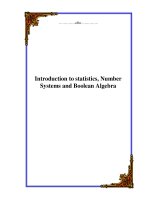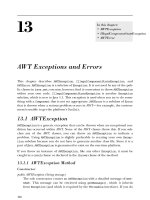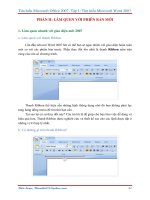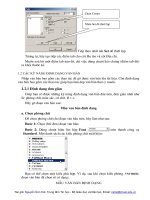INTRODUCTION TO STATISTICS THROUGH RESAMPLING METHODS AND MICROSOFT OFFICE EXCEL phần 2 docx
Bạn đang xem bản rút gọn của tài liệu. Xem và tải ngay bản đầy đủ của tài liệu tại đây (802.01 KB, 24 trang )
CHAPTER 1 VARIATION (OR WHAT STATISTICS IS ALL ABOUT) 11
FIGURE 1.7 Selecting charts and plots from the DDXL menu.
FIGURE 1.8 Selecting the type of graph desired.
out their tape measures a second time and rule off the distance from the
fingertips of the left hand to the fingertips of the right while the student
they were measuring stood with arms outstretched like a big bird. After
the assistant principal had come and gone (something about how the class
was a little noisy, and though we were obviously having a good time,
could we just be a little quieter), they recorded their results in the form of
a two-dimensional scatter plot.
They had to reenter their height data (it had been sorted, remember)
and then enter their arm span data :
Height = 141, 156.5, 162, 159, 157, 143.5, 154, 158, 140, 142, 150,
148.5, 138.5, 161, 153, 145, 147, 158.5, 160.5, 167.5, 155,
137
Arm span = 141, 156.5, 162, 159, 158, 143.5, 155.5, 160, 140, 142.5,
148, 148.5, 139, 160, 152.5, 142, 146.5, 159.5, 160.5,
164, 157, 137.5
This is trickier than it looks, because unless the data are entered in exactly
the same order by student in each data set, the results are meaningless.
(We told you that 90% of the problems are in collecting the data and
12 STATISTICS THROUGH RESAMPLING METHODS AND MICROSOFT OFFICE EXCEL
®
FIGURE 1.9 Dotplot of the classroom height data.
entering it in the computer for analysis. In another text of mine,
A Manager’s Guide to The Design and Conduct of Clinical Trials, I recom-
mend eliminating paper forms completely and entering all data directly
into the computer.) Once the two data sets have been read in, creating a
scatterplot is easy.
Well, almost easy. The first chart, Fig. 1.10, I created with the Excel
Chart menu, next to the question mark, selecting XY(Scatter) and repeat-
edly pressing Next.
To create Fig. 1.11 from the first scatterplot, I had to complete several
steps. Placing my cursor on the chart, and depressing the right mouse
button, yielded the menu shown in Fig. 1.12. Clicking on chart options
allowed me to enter a title, “Sixth Grade Data” and labels for the X and
Y axis, “Height” and “Arm Span.”
Escaping from this menu, I put my cursor on the X-axis and clicked to
bring up the menu shown in Fig. 1.13. I changed only one item, setting
the Minor tick mark type to “outside.” Then I clicked on the “Scale” tab,
removed all the check marks under “Auto,” and put in the values I
wanted as shown in Fig. 1.14. I clicked OK to obtain Fig. 1.11.
Exercise 1.3. Is performance on the LSAT used for law school admission
related to one’s grade point average? Prepare a scatterplot of the following
data drawn from a population of 82 law schools. We’ll look at this data again
later in this chapter as well as in Chapters 3 and 4.
CHAPTER 1 VARIATION (OR WHAT STATISTICS IS ALL ABOUT) 13
Arm Span
135
140
145
150
155
160
165
170
0 50 100 150 200
Arm Span
FIGURE 1.10 Scatterplot using excel’s default settings.
14 STATISTICS THROUGH RESAMPLING METHODS AND MICROSOFT OFFICE EXCEL
®
Sixth Grade Data
130
140
150
160
170
130 140 150 160 170
Height
Arm Span
FIGURE 1.11 Scatterplot using excel’s full capabilities.
FIGURE 1.12 Chart format menu.
LSAT = 576, 635, 558, 578, 666, 580, 555, 661, 651, 605, 653,
575, 545, 572, 594
GPA = 3.39, 3.3, 2.81, 3.03, 3.44, 3.07, 3, 3.43, 3.36, 3.13, 3.12,
2.74, 2.76, 2.88, 2.96
1.4.3. Percentiles of the Distribution
The values one reads from a box plot like Fig. 1.4 are approximations. To
obtain exact values for the minimum and maximum, you can sort the data
as shown in Fig. 1.5. To obtain the values of the median and other per-
centiles, we would go to Excel’s formula bar , choose “Statistical” as our
Function category if we have not already done so, and then select
“Percentile.” The result will be a display similar to Fig. 1.15.
One word of caution: Excel (like most statistics software) yields an
excessive number of digits. Because we only measured heights to the
nearest centimeter, reporting the 25th percentile as 143.875 would
CHAPTER 1 VARIATION (OR WHAT STATISTICS IS ALL ABOUT) 15
FIGURE 1.13 Format axis menu.
suggest far more precision in our measurements than actually exists.
Report the value 144 centimeters instead.
16 STATISTICS THROUGH RESAMPLING METHODS AND MICROSOFT OFFICE EXCEL
®
FIGURE 1.14 Setting up the X-axis for Fig. 1.11.
PERCENTILES
The 25th percentile of a sample is such that 25% of the observations are
smaller in value and 75% are greater. The median or 50th percentile of a
sample is such that 50% of the observations are smaller in value and 50%
are greater, and so forth. The socially conscious are concerned as much
with what the 10th percentile of a population is earning as with what the
median income is.
Still another way to display your data is via the cumulative distribution
function. Begin by sorting the data and then typing the numbers 1, 2, and
3 in Column B opposite the data values as shown in Fig. 1.16. Place your
cursor in the first entry in this column (the “1” in B3), hold down your
mouse button, and pull the cursor straight down the column, until the
numbers 1, 2, and 3 are all highlighted. Release the mouse button. Move
your cursor to the lower right corner of B5, until a plus sign appears.
Holding down the mouse button, again pull straight down Column B and
watch as Excel fills in the numbers 4, 5, , up to 22 (the number of
observations) automatically as you pull.
Enter = B3/22 in cell C3, then copy the entry in C3 all the way down
the column to C24. The result should look like Fig. 1.17. Note that the
entries in Column C are the cumulative frequencies of the observations,
that is, 0.045 are 137 or less, 0.09 are 138.5 or less, and so forth.
CHAPTER 1 VARIATION (OR WHAT STATISTICS IS ALL ABOUT) 17
FIGURE 1.15 Computing the percentiles of a sample.
FIGURE 1.16 The sorted data.
The next step in preparing a graph of these cumulative frequencies is to
insert an extra row and a column label as shown in Fig. 1.18.
Afterward, highlight the entire region between A2 and C25, select
“Charts and Plots” from the DDXL menu, and complete the resultings
Charts and Plots Dialog as shown in Fig. 1.19 to obtain the plot of Fig.
1.20.
Note that the X-axis of the cumulative distribution function extends
from the minimum to the maximum value of the class data. The Y-axis
corresponding to the cumulative frequency reveals that the probability that
18 STATISTICS THROUGH RESAMPLING METHODS AND MICROSOFT OFFICE EXCEL
®
FIGURE 1.17 Cumulative frequencies.
FIGURE 1.18 Preparing to graph the cumulative frequencies.
CHAPTER 1 VARIATION (OR WHAT STATISTICS IS ALL ABOUT) 19
FIGURE 1.19 Plotting the empirical cumulative distribution function.
FIGURE 1.20 Cumulative distribution of heights of Dr. Good’s sixth-
grade class.
a data value is less than the minimum is 0 (you knew that) and the proba-
bility that a data value is less than or equal to the maximum is 1. Using a
ruler, see what X value or values correspond to 0.5 on the Y-scale.
Exercise 1.4. What do we call this value(s)?
Exercise 1.5. Construct cumulative distribution functions for the data
you’ve collected.
1.5. TYPES OF DATA
Statistics such as the minimum, maximum, median, and percentiles make
sense only if the data is ordinal, that is, if it can be ordered from smallest
to largest. Clearly height, weight, number of voters, and blood pressure
are ordinal. So are the answers to survey questions such as “How do you
feel about President Bush?”
Ordinal data can be subdivided into metric and nonmetric data. Metric
data like heights and weights can be added and subtracted. We can
compute the mean as well as the median of metric data. (We can further
subdivide metric data into observations like time that can be measured on
a continuous scale and counts such as “buses per hour” that are discrete.)
But what is the average of “He’s destroying our country” and “He’s no
worse than any other politician”? Such preference data is ordinal, in that it
may be ordered, but it is not metric.
Many times, in order to analyze ordinal data, statisticians will impose a
metric on it—assigning, for example, weight 1 to “Bush is destroying our
country” and weight 5 to “Bush is no worse than any other politician.”
Such analyses are suspect, for another observer using a different set of
weights might get quite a different answer.
The answers to other survey questions are not so readily ordered. For
example, “What is your favorite color?” Oops, bad example, because we
can associate a metric wavelength with each color. Consider instead the
answers to “What is your favorite breed of dog?” or “What country do
your grandparents come from?” The answers to these questions fall into
nonordered categories. Pie charts and bar charts are used to display such
categorical data, and contingency tables are used to analyze them. A scat-
terplot of categorical data would not make sense.
Exercise 1.6. For each of the following, state whether the data are metric
and ordinal, only ordinal, categorical, or you can’t tell:
20
STATISTICS THROUGH RESAMPLING METHODS AND MICROSOFT OFFICE EXCEL
®
a) Temperature
b) Concert tickets
c) Missing data
d) Postal codes
1.5.1. Depicting Categorical Data
Three of the students in my class were of Asian origin, 18 were of Euro-
pean origin (if many generations back), and one was part Indian. To
depict these categories in the form of a pie chart, I first entered the cate-
gorical data Asia, Europe, and India in Column A and the corresponding
numbers 3, 18, 1 in Column B.
To obtain the exploded pie chart in Fig. 1.21, I first used my cursor to
outline the area on the speadsheet in which I’d typed my data. I selected
the Chart Wizard from Excel’s own menu bar, clicked on the Custom
Types tab, selected Pie Explosion, and then went step by step through the
resulting dialog.
A pie chart also lends itself to the depiction of ordinal data resulting
from surveys. If you did a survey as your data collection project, make a
pie chart of your results now.
Such plots and charts have several purposes. One is to summarize the
data. Another is to compare different samples or different populations
(girls versus boys, my class versus your class). For example, we can enter
gender data for the students, being careful to enter the gender codes in
the same order in which the students’ heights and arm spans already
have been entered. As shown in Fig. 1.22, the first student on our
CHAPTER 1 VARIATION (OR WHAT STATISTICS IS ALL ABOUT) 21
Origins of Classmates
Asia
14%
Europe
81%
India
5%
FIGURE 1.21 Region of origin of classmates.
list is a boy, the next seven are girls, then another boy, six girls, and finally
seven boys.
To create the side-by-side boxplots shown in Fig. 1.23, we selected
“Boxplot by Groups” from the DDXL Charts and Plots menu.
Exercise 1.7. Create a boxplot of arm span by sex for the classdata. Also,
create a pie chart by sex for the classdata.
22 STATISTICS THROUGH RESAMPLING METHODS AND MICROSOFT OFFICE EXCEL
®
FIGURE 1.22 Classdata by sex of student.
FIGURE 1.23 Boxplot of class heights by sex.
The primary value of charts and graphs is as an aid to critical thinking.
The figures in this specific example may make you start wondering about
the uneven way in which adolescents go about their growth. The exciting
thing, whether you are a parent or a middle-school teacher, is to observe
how adolescents get more heterogeneous, more individual with each
passing year.
1.5.2. From Observations to Questions
You may want to formulate your theories and suspicions in the form of
questions: Are girls in the sixth grade taller on the average than sixth-
grade boys (not just those in Dr. Good’s sixth-grade class, but in all sixth-
grade classes)? Are they more homogeneous, that is, less variable, in terms
of height? What is the average height of a sixth grader? How reliable is
this estimate? Can height be used to predict arm span in sixth grade? Can
it be used to predict the arm spans of students of any age?
You’ll find straightforward techniques in subsequent chapters for
answering these and other questions. First, we suspect, you’d like the
answer to one really big question: Is statistics really much more difficult
than the sixth-grade exercise we just completed? No, this is about as com-
plicated as it gets.
1.6. MEASURES OF LOCATION
Far too often, we find ourselves put on the spot, forced to come up with a
one-word description of our results when several pages or, better still,
several charts would do. “Take all the time you like,” coming from a boss,
usually means “Tell me in 10 words or less.”
If you were asked to use a single number to describe data you’ve col-
lected, what number would you use? One answer is “the one in the
middle,” the median that we defined earlier in this chapter.
In the majority of cases, we recommend using the arithmetic mean or
arithmetic average rather than the median. To calculate the mean of a
sample of observations by hand, one adds up the values of the observa-
tions, then divides by the number of observations in the sample. If we
observe 3.1, 4.5, and 4.4, the arithmetic mean would be 12/3 = 4. In
symbols, we write the mean of a sample of n observations, X
i
with i = 1,
2, , n as .
4
XX Xn
n
XX
ni
i
n
12
1
1
++
()
==
=
Â
CHAPTER 1 VARIATION (OR WHAT STATISTICS IS ALL ABOUT) 23
4
The Greek letter S is pronounced “sigma”.
Is adding a set of numbers and then dividing by the number in the set
too much work? To find the mean height of the students in my classroom,
we would use Excel’s average function.
A playground seesaw (or teeter-totter) is symmetric in the absence of
kids. Its midpoint or median corresponds to its center of gravity or its
mean. If you put a heavy kid at one end and two light kids at the other so
that the seesaw balances, the mean will still be at the pivot point, but the
median is located at the second kid.
Another population parameter of interest is the most frequent observa-
tion or mode. In the sample 2, 2, 3, 4 and 5, the mode is 2. Often the
mode is the same as the median or close to it. Sometimes it’s quite differ-
ent, and sometimes, particularly when there is a mixture of populations,
there may be several modes.
Consider the data on heights collected in my sixth-grade classroom. The
mode is at 157.5cm. But aren’t there really two modes, one correspond-
ing to the boys, the other to the girls in the class?
As you can see from Fig. 1.24, a histogram of the heights of my sixth-
graders provides evidence of two modes. When we don’t know in advance
how many subpopulations there are, modes serve a second purpose: to
help establish the number of subpopulations.
24
STATISTICS THROUGH RESAMPLING METHODS AND MICROSOFT OFFICE EXCEL
®
Histogram of Class Data
0
1
2
3
4
5
6
7
135 140 145 150 155 160 165 170
Frequency
FIGURE 1.24 Histogram of class data.
To construct this histogram, I downloaded a trial version of XLStat
from and installed this
program after selecting “Add-ins” from Excel’s Tools menu.
As you can see from Fig. 1.25, I selected Describing Data and the His-
tograms from XLStat’s menu.
Exercise 1.8. Compare the mean, median, and mode of the data you’ve
collected.
Exercise 1.9. A histogram can be of value in locating the modes when there
are 20 to several hundred observations, because it groups the data. Draw
histograms for the data you’ve collected.
1.6.1. Which Measure of Location?
The mean, the median, and the mode are examples of sample statistics.
Statistics serve three purposes:
1. Summarizing data
2. Estimating population parameters
3. Aids to decision making
Our choice of one statistic rather than another depends on the use(s) to
which it is to be put.
CHAPTER 1 VARIATION (OR WHAT STATISTICS IS ALL ABOUT) 25
FIGURE 1.25 Using XLStat to create a histogram from the class heights.
For summarizing data: Graphs—boxplots, strip plots, cumulative dis-
tribution functions, and histograms—are essential. If you’re not going to
use a histogram, then for samples of 20 or more be sure to report the
number of modes.
We always recommend using the median if the data are ordinal but not
metric, as well as when the distribution is highly skewed with a few very
large or very small values.
Two good examples of skewness are incomes and house prices. A recent
Los Angeles Times featured a great house in Beverly Park at $80 million
US. A house like that has a large effect on the mean price of homes in an
area. The median house price is far more representative than the mean,
even in Beverly Hills.
The weakness of the arithmetic mean is that it is too easily biased by
extreme values. If we eliminate Pedro from our sample of sixth graders—
he’s exceptionally tall for his age at 5¢7≤ or 167cm—the mean would
change from 151.6 to 3167/21 = 150.8 cm. The median would change to
a much lesser degree, shifting from 153.5 to 153 cm. Because the median
is not as readily biased by extreme values, we say that the median is more
robust than the mean.
For estimation: In deciding which sample statistic to use in estimating the
corresponding population parameter, we need to distinguish between pre-
cision and accuracy. Let us suppose that Robin Hood and the Sheriff of
Nottingham engage in an archery contest. Each is to launch three arrows
at a target 50 meters (half a soccer pitch) away. The Sheriff launches first,
and his three arrows land one atop the other in a dazzling display of
shooting precision. Unfortunately, all three arrows penetrate and fatally
wound a cow grazing peacefully in the grass nearby. The Sheriff’s accuracy
leaves much to be desired.
26
STATISTICS THROUGH RESAMPLING METHODS AND MICROSOFT OFFICE EXCEL
®
THE CENTER OF A POPULATION
Median: the value in the middle; the halfway point; that value which has
equal numbers of larger and smaller elements around it.
Arithmetic mean or arithmetic average: the sum of all the elements divided
by their number or, equivalently, that value such that the sum of the devia-
tions of all the elements from it is zero.
Mode: the most frequent value. If a population consists of several sub-
populations, there may be several modes.
We can show mathematically that for very large samples the sample
median and the median of the population from which the sample is drawn
will almost coincide. The same is true for large samples and the mean.
Alas, “large” in this instance may mean larger than we can afford. As you
saw in Exercise 1.1, gathering data takes time and money. With small
samples, the accuracy of an estimator is always suspect.
With most of the samples we encounter in practice, we can expect the
value of the sample median and virtually any other estimator to vary from
sample to sample. One way to find out for small samples how precise a
method of estimation is would be to take a second sample the same size as
the first and see how the estimator varies between the two, then a third,
and fourth, , say 20 samples. But a large sample will always yield more
precise results than a small one. So, if we’d been able to afford it, the sensi-
ble thing would have been to take 20 times as large a sample to begin
with.
5
Still, there is an alternative. We can treat our sample as if it were the
original population and take a series of bootstrap samples from it. The vari-
ation in the value of the estimator from bootstrap sample to bootstrap
sample will be a measure of the variation to be expected in the estimator
had we been able to afford to take a series of samples from the population
itself. The larger the size of the original sample, the closer it will be in
composition to the population from which it was drawn, and the more
accurate this measure of precision will be.
1.6.2. The Bootstrap
Let’s see how this process, called bootstrapping, would work with a spe-
cific set of data. Once again, here are the heights of the 22 students in my
sixth-grade class, measured in centimeters and ordered from shortest to
tallest:
137.0 138.5 140.0 141.0 142.0 143.5 145.0 147.0 148.5
150.0 153.0 154.0 155.0 156.6 157.0 158.0 158.5 159.0
160.5 161.0 162.0 167.5
Let’s assume we record each student’s height on an index card, 22 index
cards in all. We put the cards in a big hat, shake them up, pull one out,
and make a note of the height recorded on it. We return the card to the
hat and repeat the procedure for a total of 22 times until I have a second
CHAPTER 1 VARIATION (OR WHAT STATISTICS IS ALL ABOUT) 27
5
Of course, there is a point at which each additional observation will cost more than it
yields in information. The bootstrap described here will also help us to find the “optimal”
sample size.
sample, the same size as the original. Note that we may draw Jane’s
card several times as a result of using this method of sampling with
replacement.
Our first bootstrap sample, arranged in increasing order of magnitude
for ease in reading, might look like this:
138.5 138.5 140.0 141.0 141.0 143.5 145.0 147.0 148.5 150.0 153.0
154.0 155.0 156.5 157.0 158.5 159.0 159.0 159.0 160.5 161.0 162.
Several of the values have been repeated; not surprising as we are sampling
with replacement, treating the original sample as a stand-in for the much
larger population from which the original sample was drawn. The
minimum of this bootstrap sample is 138.5, higher than that of the origi-
nal sample; the maximum at 162.0 is less than the original, whereas the
median remains unchanged at 153.5.
137.0 138.5 138.5 141.0 141.0 142.0 143.5 145.0 145.0 147.0
148.5 148.5 150.0 150.0 153.0 155.0 158.0 158.5 160.5 160.5
161.0 167.5
In this second bootstrap sample, again we find repeated values; this time
the minimum, maximum, and median are 137.0, 167.5, and 148.5,
respectively.
Two bootstrap samples cannot tell us very much. But suppose we were
to take 50 or 100 such samples. Here is a one-way strip plot of the
28
STATISTICS THROUGH RESAMPLING METHODS AND MICROSOFT OFFICE EXCEL
®
medians of 50 bootstrap samples taken from the classroom data:
These values provide an insight into what might have been had we
sampled repeatedly from the original population.
Quick question: What is that population? Does it consist of all classes at
the school where I was teaching? All sixth-grade classes in the district? All
sixth-grade classes in the state? The school was Episcopalian, so perhaps
the population was all sixth-grade classes in Episcopalian schools.
To apply the bootstrap, you’ll need to download and install a trial
version of the Resampling Stats in Excel add-in from http://www.
resample.com/content/software/excel/download.shtml
Before you add it in, make sure that the “Analysis Toolpak” and “Analy-
sis Toolpak VBA” options are checked in Excel’s Tools/Add-ins menu.
Clicking on the R on the newly appeared Resampling Stats in Excel
menu yields the display of Fig. 1.26. Pressing OK in the dialog box
results in a single bootstrap sample (with replacement) in the second
column.
To obtain a confidence interval for the 25th percentile of the original
sample, I inserted the percentile formula in the first cell immediately
beneath the bootstrap sample as in Fig. 1.27. I clicked on the RS on
Resampling Stats in Excel menu, and the 25th percentile of each of 100
bootstrap samples was displayed in the first column of a second worksheet,
labeled “Results.” To obtain a confidence interval for the original esti-
mate, I sorted the values in the column and then selected the end points
of the interval. In Fig. 1.28 we see that in 90 out of 100 instances, the
25th percentile of the bootstrap sample was 150.75 or less.
Exercise 1.10. Our original question, you’ll recall, is which is the least vari-
able (most precise) estimate: mean or median? To answer this question, at
least for the data on heights I collected in my classroom, apply the boot-
strap, then construct side-by-side boxplots for the results.
CHAPTER 1 VARIATION (OR WHAT STATISTICS IS ALL ABOUT) 29
FIGURE 1.26 Preparing to generate a bootstrap sample.
Exercise 1.11. Apply the bootstrap to the data you collected in Exercise
1.1 to see whether the mean or the median is the more precise estimator.
Exercise 1.12. Can you tell which is the more accurate estimator in the two
previous cases? If not, why not?
1.7. SAMPLES AND POPULATIONS
If it weren’t for person-to-person variation, it really would be easy to find
out what brand of breakfast cereal people prefer or which movie star they
30
STATISTICS THROUGH RESAMPLING METHODS AND MICROSOFT OFFICE EXCEL
®
FIGURE 1.27 First step in getting a confidence interval for P
25
.
FIGURE 1.28 The eight largest values of the 25th percentile for 100 boot-
strap samples.
want as their leader. Interrogate the first person you encounter on the
street and all will be revealed. As things stand, we must either pay for and
take a total census of everyone’s view (the cost of the 2003 recall election
in California pushed an already near-bankrupt state one step closer to the
edge) or take a sample and learn how to extrapolate from that sample to
the entire population.
In each of the data collection examples in Section 1.2, our observations
were limited to a sample from a population. We measured the height, cir-
cumference, and weight of a dozen humans (or dogs, or hamsters, or
frogs, or crickets) but not all humans or dogs or hamsters. We timed some
individuals (or frogs or turtles) in races but not all. We interviewed some
fellow students but not all.
If we had interviewed a different set of students, would we have
gotten the same results? Probably not. Would the means, medians, IQRs,
and so forth have been similar for the two sets of students? Maybe, if
the two samples had been large enough and similar to each other in
composition.
If we interviewed a sample of women and a sample of men regarding
their views on women’s right to choose, would we get similar answers?
Probably not, as these samples would be drawn from completely different
populations (different, that is, with regard to their views on women’s right
to choose). If we want to know how the citizenry as a whole feels about
an issue, we need to be sure to interview both men and women.
In every statistical study, two questions immediately arise:
1. How large should my sample be?
2. How can I be sure this sample is representative of the population in
which my interest lies?
By the end of Chapter 5, we’ll have enough statistical knowledge to
address the first question, but we can start now to discuss the second.
After I deposited my ballot in a recent election, I walked up to the
interviewer from the Los Angeles Times who was taking an exit poll and
offered to tell her how I’d voted. “Sorry,” she said, “I can only interview
every ninth person.”
What kind of a survey wouldn’t want my views? Obviously, a survey that
wanted to ensure that shy people were as well represented as boisterous
people and that a small group of activists couldn’t bias the results.
6
CHAPTER 1 VARIATION (OR WHAT STATISTICS IS ALL ABOUT) 31
6
To see how surveys could be biased deliberately, you might enjoy reading Grisham’s The
Chamber.
One sample we would all insist be representative is the jury.
7
The
Federal Jury Selection and Service Act of 1968 as revised
8
states that citi-
zens cannot be disqualified from jury duty “on account of race, color, reli-
gion, sex, national origin or economic status.”
9
The California Code of
Civil Procedure, section 197, tells us how to get a representative sample.
First, you must be sure your sample is taken from the appropriate popula-
tion. In the case of California, the “list of registered voters and the
Department of Motor Vehicles list of licensed drivers and identification
card holders . . . shall be considered inclusive of a representative cross
section of the population.” The Code goes on to describe how a table
of random numbers or a computer could be used to make the actual
selection. The bottom line is that to obtain a random, representative
sample:
•
Each individual (or item) in the population must have an equal
probability of being selected.
•
No individual (item) or class of individuals may be discriminated
against.
There’s good news and bad news. The bad news is that any individual
sample may not be representative. You can flip a coin six times, and every
so often it will come up heads six times in a row. A jury may consist
entirely of white males. The good news is that as we draw larger and
larger samples, samples will resemble the population from which they are
drawn more and more closely.
Exercise 1.13. For each of the three data collection examples of Section
1.2, describe the populations you would hope to extend your conclusions to
and how you would go about ensuring that your samples were representa-
tive in each instance.
1.7.1. Drawing a Random Sample
Recently, one of our clients asked for help with an audit. Some errors had
been discovered in an invoice they’d submitted to the government for
reimbursement. Because this client, an HMO, made hundreds of such
submissions each month, they wanted to know how prevalent such errors
were. Could we help them select a sample for analysis?
32
STATISTICS THROUGH RESAMPLING METHODS AND MICROSOFT OFFICE EXCEL
®
7
Unless, of course, we are the ones on trial.
8
28 U.S.C.A. x1861 et. seq (1993).
9
See 28 U.S.C.A. x1862 (1993).
We could, but we needed to ask the client some questions first. We had
to determine what the population was from which the sample would be
taken and what constituted a sampling unit.
Were we interested in all submissions or just some of them? The client
told us that some submissions went to state agencies and some to Federal
agencies, but for audit purposes their sole interest was in certain Federal
submissions, specifically in submissions for reimbursement for a certain
type of equipment. Here, too, a distinction needed to be made between
custom equipment (with respect to which there was virtually never an
error) and more common off-the-shelf supplies. At this point in the inves-
tigation, our client breathed a sigh of relief. We’d earned our fee, it
appeared, merely by observing that instead of 10,000 plus potentially
erroneous claims, the entire population of interest consisted of only 900
or so items. (When you read earlier that 90% of the effort in statistics was
in collecting the data, we meant exactly that.)
Our client’s staff, like that of most businesses, was used to working with
an electronic spreadsheet. “Can you get us a list of all the files in spread-
sheet form?” we asked.
CHAPTER 1 VARIATION (OR WHAT STATISTICS IS ALL ABOUT) 33
Name Start Date
Reed, Agnes 23-Jan-03 0.0055
Ellis, Cynthia 24-Jun-03 0.0991
Wolfe, Carissa 25-Jun-03 0.0173
Rooney, Kevin 9-Jul-03 0.0332
Lane, Lori 18-Jul-03 0.0550
Russo, Will 25-Jul-03 0.1983
Gabel, Steven 28-Jul-03 0.1767
Reed, Oliver 1-Aug-03 0.1913
Huff, Elouise 5-Aug-03 0.0916
Files Sorted By Date
They could and did. The first column of the spreadsheet held each
claim’s ID. The second held the date. We used the spreadsheet’s sort
function to sort all the claims by date and then deleted all those that fell
outside the date range of interest. Next, we inserted a new column and in
the top cell (just below the label row) of the new column, we put the
command =rand(). We copied this command all the way down the
column, using Windows’ standard cut and paste commands ctrl-C and
ctrl-V.
A series of numbers was displayed down the column. To lock these in
place, we went to the Tools menu, clicked on “options” and then on the
calculation tab. We made sure that Calculation was set to manual and
there was no check mark opposite “recalculate before save.”
Now, we resorted the data based on the results of this column. Before-
hand, we’d decided there would be exactly 35 claims in the sample, so we
simply cut and pasted the top 35 items.
1.7.2. Ensuring the Sample is Representative
Exercise 1.14. We’ve already noted that a random sample might not be rep-
resentative. By chance alone, our sample might include men only, or African
Americans but no Asians, or no smokers. How would you go about ensur-
ing that a random sample is representative?
1.8. VARIATION—WITHIN AND BETWEEN
Our work so far has revealed that the values of our observations vary
within a sample as well as between samples taken from the same popula-
tion. Not surprisingly, we can expect even greater variability when our
samples are drawn from different populations. Several different statistics
are used to characterize and report on the within-sample variation.
The most common statistic is termed the variance and is defined as the
sum of the squares of the deviations of the individual observations about
their mean divided by the sample size minus 1. In symbols, if our observa-
tions are labeled X
1
, X
2
, up to X
n
, and the mean of these observations is
written as X
¯
, then the variance s
2
(pronounced sigma squared) is equal to
1
1
1
2
n
XX
i
i
n
-
()
-
()
=
Â
.
34 STATISTICS THROUGH RESAMPLING METHODS AND MICROSOFT OFFICE EXCEL
®
Name Start Date rand()
Reed, Agnes 23-Jan-03 0.0055
Hason, Arnold 13-Aug-03 0.0104
Wolfe, Carissa 25-Jun-03 0.0173
Sartre, Jean-Paul 17-Oct-03 0.0222
Brown, James 29-Oct-03 0.0226
Rooney, Kevin 9-Jul-03 0.0332
Mills, Louise 4-Sep-03 0.0412
Smith, Thomas 2-Oct-03 0.0497
Dudley, Morris 8-Aug-03 0.0540
Files Insluded in Initial Audit









